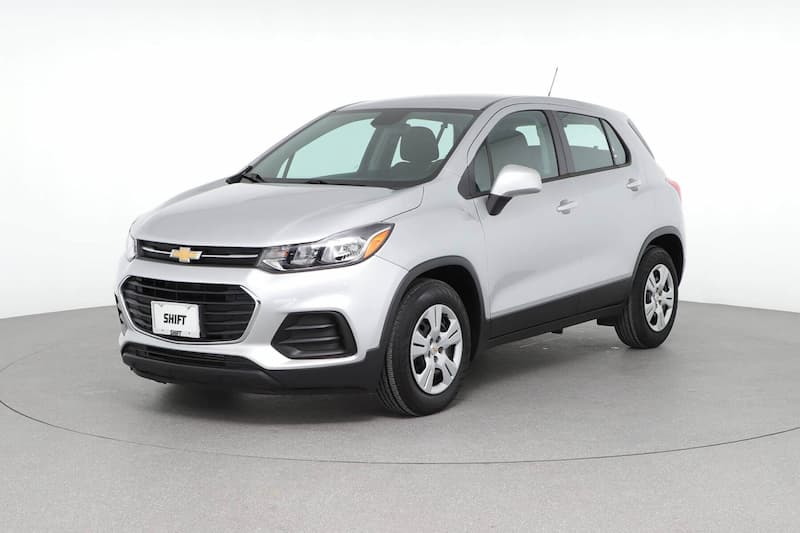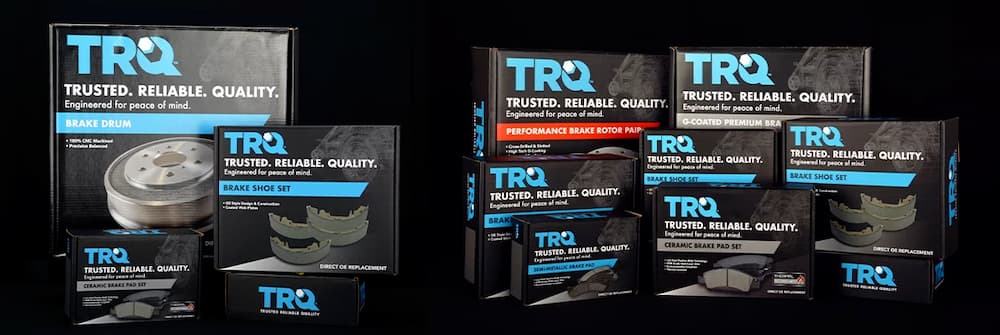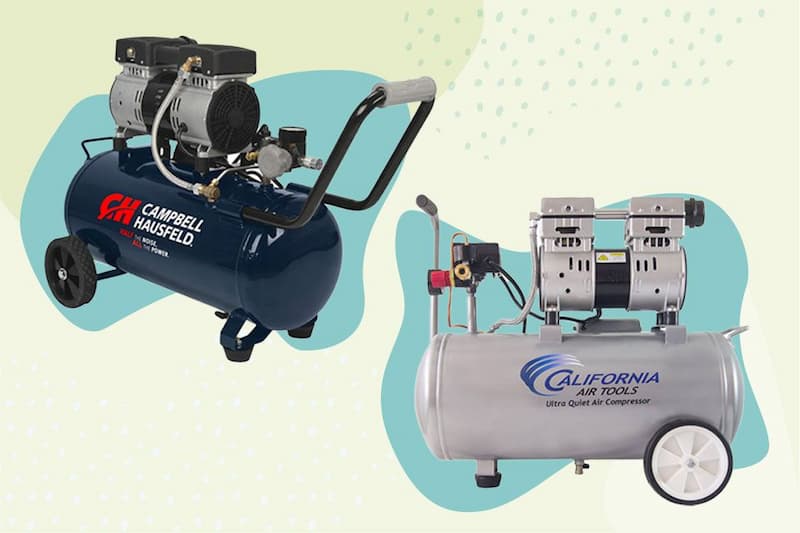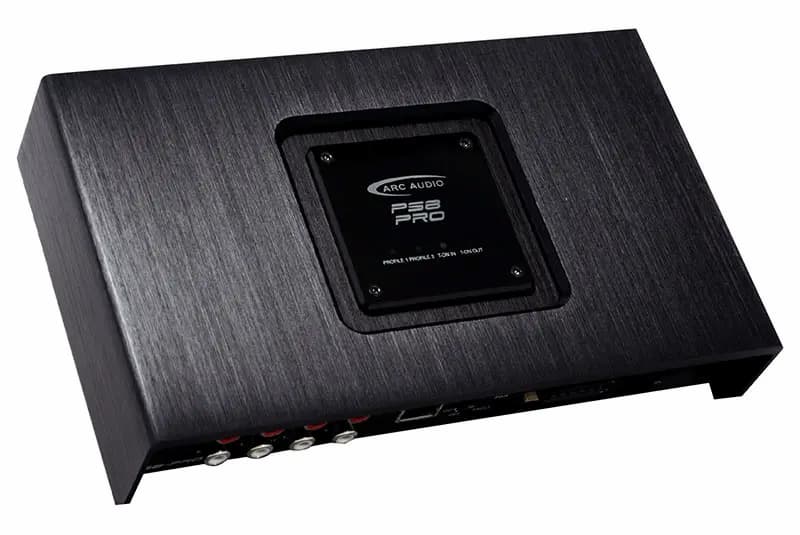In comparison to earlier models, where an AM radio might have been an extra-cost option, many modern cars now come with respectable stereo systems. However, it’s possible that you would prefer to upgrade the audio in your car without having to pay more for unproven factory parts.
Thankfully, the aftermarket will let you upgrade to the best car speakers available, many of which are direct replacements so you don’t have to worry about complicated wiring, getting a new head unit or even adding an amplifier to your car. Given that most modern vehicles have complicated infotainment systems that are difficult to remove, this is particularly crucial.
When shopping for replacement car speakers, make sure you’re getting the correct size speakers for your specific car. Otherwise, you might want to think about having a custom installation made.
Our best car speakers include Kicker DSC650 DS Series, JL Audio C5-570X, Focal RCX-690, Focal PC 165 FE, Focal PS 165 FXE, Polk Audio DB6502…
If you know a little about wiring and how stereo systems operate, you could install the OE replacement speakers we recommend on this list in your own garage.
best car speakers
For more information, continue reading.
Table of Contents
Best Car Speakers
Kicker DSC650 DS Series
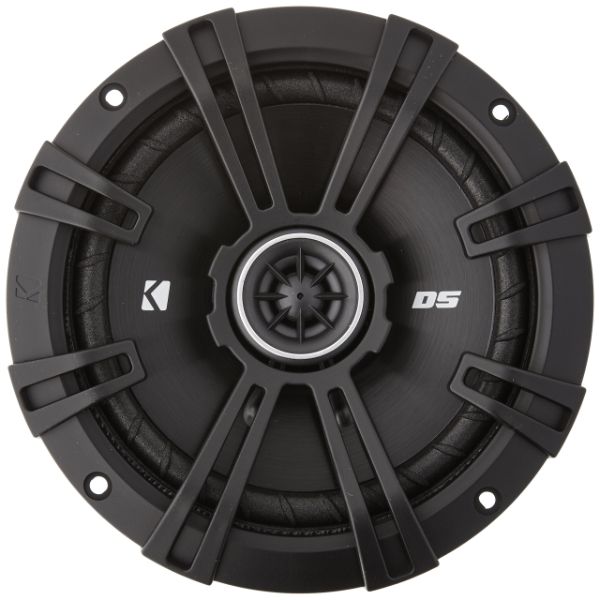
If you find yourself in need of a good-quality pair of speakers that will run well off your factory-installed radio, Kicker’s DS-series 43DSC6504 6-1/2″ 2-way coaxial speakers should be at the top of your list of suitable solutions. The speakers’ woofer cones are made of a durable polypropylene material that will belt out solid midrange and midbass response, while the 1/2″ Each speaker’s center-placed PEI dome tweeters produce clear high-frequency response. Each speaker’s woofer cones and basket are connected well by a foam surround with ribs. One of the best car speakers is this one.
These 4-ohm speakers can operate at peak power levels of up to 240 watts, but they perform well at lower continuous power levels of 10 to 60 watts. That works out perfectly if you pair them with an aftermarket or factory-installed radio. With a mounting depth of just 1-13/16″, you should have few issues fitting them into most speaker locations. Let’s say you want to shield the speakers in some way. To safeguard your audio investment in that situation, a pair of durable plastic grilles are included. It might be time to replace those subpar speakers in your car, in our opinion. Don’t you agree?
JL Audio C5-570X
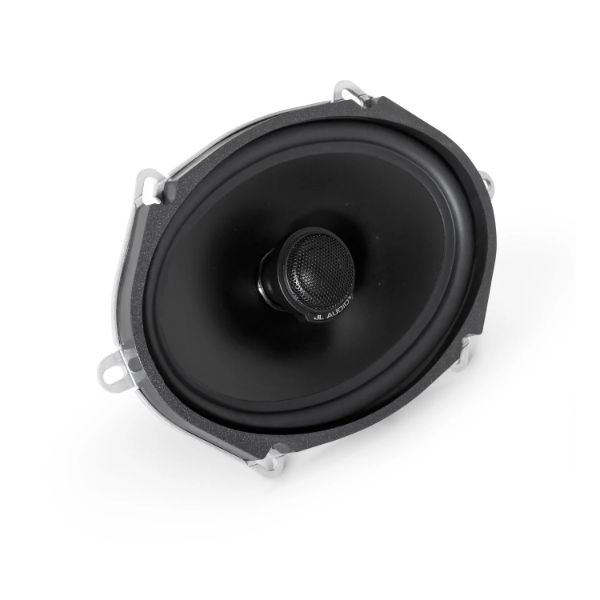
Starting this list off right, we’ll demonstrate the ultimate improvement you can make to your vehicle’s audio system. This package isn’t cheap, but in terms of performance, you get what you pay for. This package includes a pair of the newest Evolution-series JL Audio 5×7″ coaxial speakers and a pair of adjustable crossovers.
JL Audio’s engineers meticulously tune these speakers to deliver a depth and richness that you won’t find in comparably sized round speakers while enhancing the entire sound spectrum with high-end parts. With the addition of vibration dampening, the polypropylene cone with mica injection offers excellent rigidity and enhances midrange frequencies.
These coaxial speakers also feature three-quarter-inch silk dome tweeters that are perfectly matched to the woofers’ rich, deep sound. Four levels of tweeter attenuation and three levels of midrange presence adjustment are provided by the included crossover network. Dial your system in and enjoy the cleanest sound you’ve ever heard from a 5×7″ speaker.
Focal RCX-690
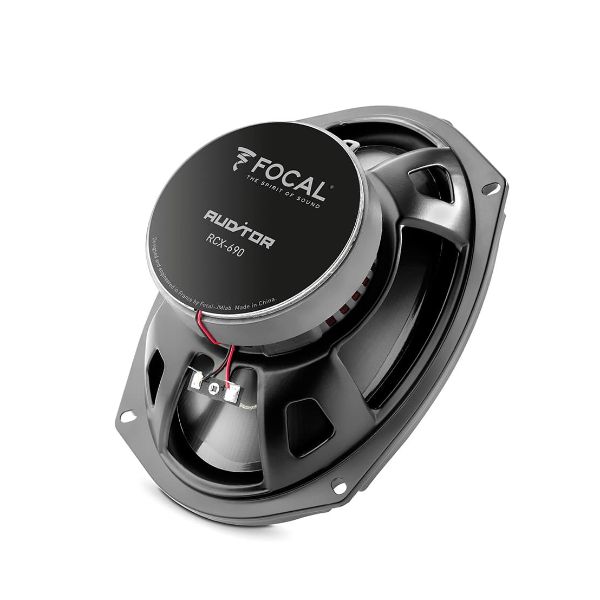
The RCX-690 6x9s from Focal are another option on our list (there’s a pattern here). Great speakers cost a lot of money, and French manufacturer Focal is well known for its excellent products. The Auditor Series is marketed as an entry-level speaker, but in terms of both cost and performance, it’s far from it. The Performance 690C, an earlier version of Focal’s product, was previously highlighted on our 6×9 list. The grills in the new design are much better looking and use better basket geometry. It’s important to remember that the only difference between the old and new designs is how they look; all other technical specifications and materials are equivalent. One of the best car speakers is this one.
It is a three-way design, the RCX-690. It uses an inverted mylar dome tweeter and an inverted dome super tweeter speaker to provide high-end quality without breaking the bank. We adore how these speakers are designed simply and how well they perform given their price. Simply put, they’re a fantastic set of 6×9.
The RSX-690 has a strong, rigid double-arm steel basket for stability. An internal polypropylene cone with a rubber surround allows the motor to move the cone like a piston while restricting flex and horizontal movement.
The authenticity of the sound is really where you’ll hear how these speakers differ from other brands. Vocals are natural and smooth, the bass is rich, and the snare drums are tight and sharp. Although you can find great speakers from other brands, you won’t find a three-way speaker that sounds this good for less money.
Focal PC 165 FE
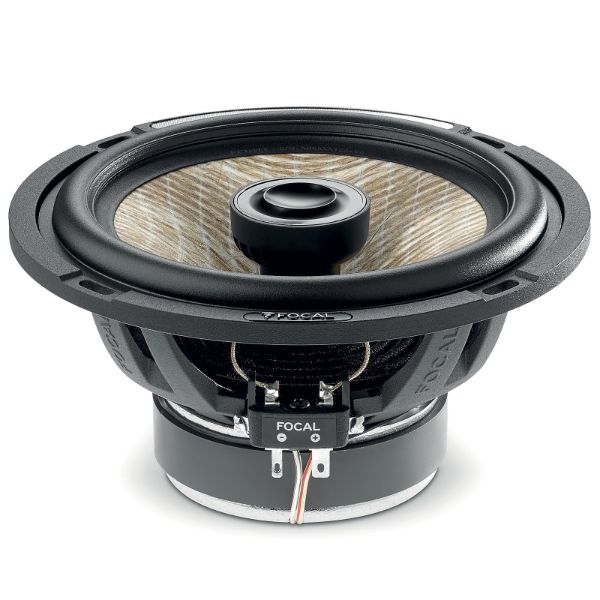
We’ve always been big fans of Focal products. We’ve featured their products in various best lists for years now, including our list of best 6.5″ component speakers. There was a K2 Power before there was a PC 165 FE. A list of suggested car speaker brands should never leave out a few names, Focal being one of them.
You’ll want to hear these Focals after just one look. For a 6 1/2-inch coaxial speaker, we think the PC 165 FE is the best option. Its flax-fiber woofer cone is a pretty special Focal feature. Flaxseed, a common material historically used for textiles, parchment, and other things, is the source of flax cones. Since flax naturally dampens unwanted vibrations and is lightweight and incredibly durable, it makes an ideal cone material for acoustics. Furthermore, Focal’s TMD (tuned mass damper) surround is designed to optimize the cone’s performance and movement. Check out Focal’s article for more information on competitive evaluations of some of the TMD substitutes. Pretty cool.
Although the flax is one of our personal favorites, the basket/frame is another. A cast aluminum object, specifically a magnesium aluminum alloy, exudes strength, durability, and quality. Finish it off with some lovely laser engraving on the frame; without even connecting the speakers to power, it’s the small (and occasionally silly) details that Focal pays attention to that really give you confidence in their products.
The tweeter’s inverted “M-Profile” dome cone is another example of creative engineering. Without having to position the tweeters in a specific direction, this enables sound to disperse at a wider angle, enhancing sound quality at extreme angles (like your A-Pillar).
Overall, the PC 165 FE is a fantastic option and currently our top pick for a 6.5 coaxial speaker.
Focal PS 165 FXE
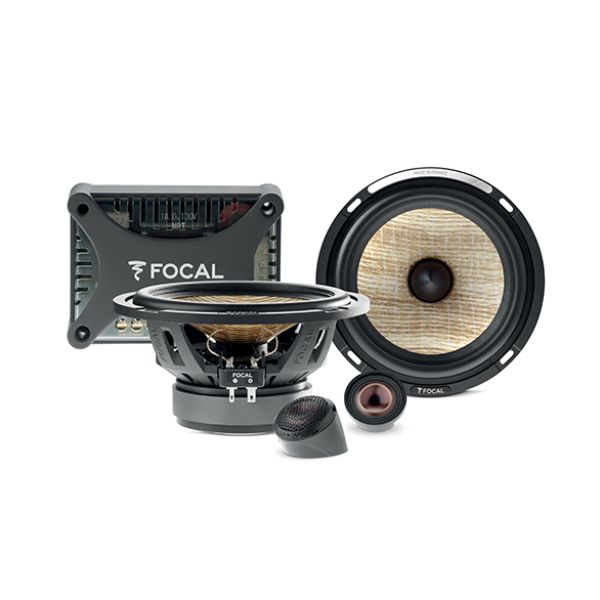
Focal is committed to producing high-fidelity audio for the automotive industry. The PS 165 FXE, a brand-new 6.5-inch component set from the French company, combines some of the highest-end technology available with the company’s renowned use of flax fibers to create the best-sounding component speakers in the entire world.
The PS 165 FXE and PC 165 FE both use flax technology, TMD surround, “M-dome” tweeters, and cast aluminum frames, among other things. Therefore, in order to reduce redundancy, we advise you to read the PC 165 FE’s quick review above. We are aware that these are expensive, but there is a good reason for that. Anyone who works in the home and auto stereo industry will be familiar with Focal. We conducted a first look and feature overview of the PS 165 FXE and were very pleased with what we discovered. They are the people we choose for our personal vehicles.
Polk Audio DB6502
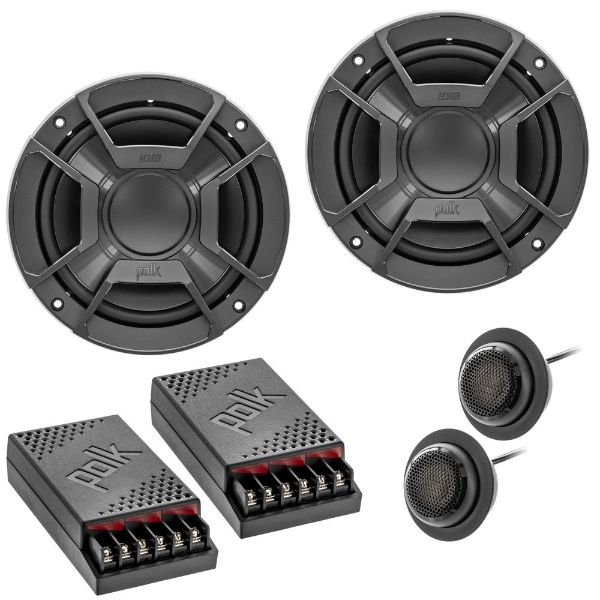
Sometimes all you need is a reasonably priced speaker that does the job, sounds great, and won’t break the bank. The improved version of the Polk Audio DB6501 is the DB6502. Polk DB has always been a favorite of ours. On our lists, they rank among the most well-liked speakers. They not only offer excellent value and performance for the money. Additionally, they are designed to sound great in the harshest environments, such as boats, UTVs, and other outdoor applications, thanks to features like a polypropylene and UV-protectant cone and waterproof inner and outer surrounds. So it stands to reason that one of our favorite features of these speakers is their IP55 marine certification, which makes them a fantastic option for marine and outdoor applications! The DB6502 is at the top of our list of the best value 6.5″ component car speakers overall because they’re a great deal.
Morel Supremo 602
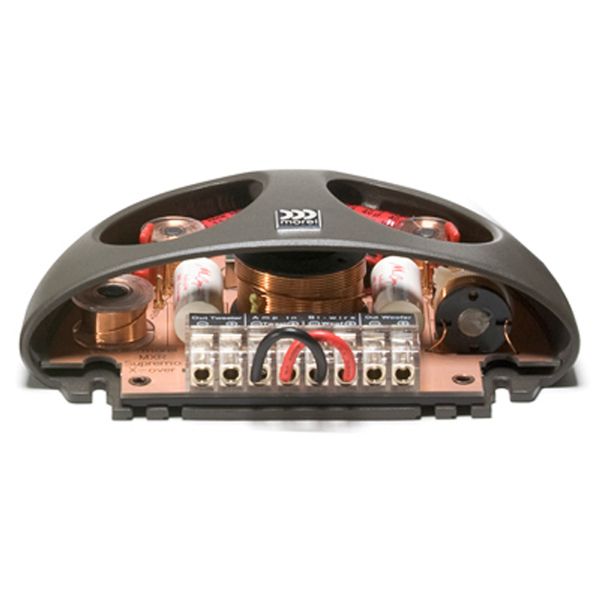
In contrast, this would be your choice if you have deep pockets and a high-profile car whose outrageous sound system you want to match. The Morel Supremo 602, which won the 2012 CEA Innovation Award, is Morel’s premier component speaker for the automotive industry. These elements produce precise, linear, dynamic sound that spans a wide range of frequencies. Additionally, you can count on positive phase, sharp roll-off, and resistor-free signal paths in crossovers designed to handle the most demanding automotive acoustic conditions to completely integrate the Supremo components’ sounds and recreate a true three-dimensional sound.
Despite being outrageously expensive, Morel speakers elevate car audio with their appearance, design, and functionality. Here is a good choice if excellence is what you seek. It is among the best car speakers.
Rockford Fosgate Power T1682
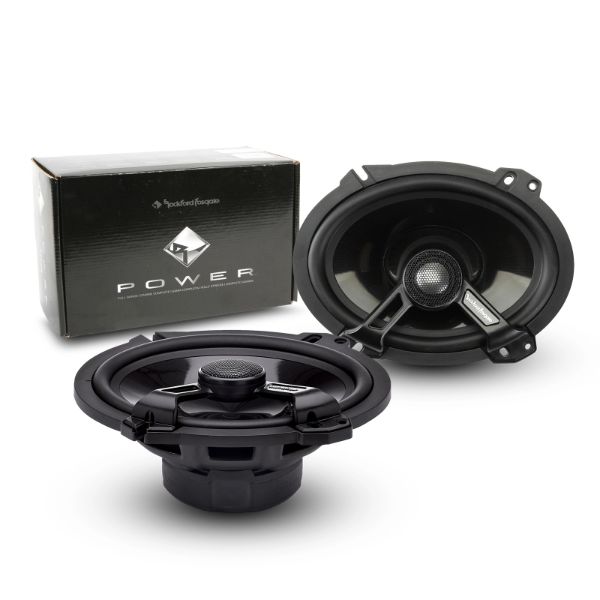
Rockford Fosgate might be the best option for you if you’re looking for a great speaker to replace blown or subpar factory units. These speakers have rigid, lightweight, polypropylene and carbon fiber injected cones that are also reliable and long-lasting. This style reduces the off-sounds that many oval speakers have a tendency to produce while enhancing midrange frequencies. Dynamic high range frequencies are provided by an aluminum one-inch tweeter.
The integrated crossover is a feature we like particularly well. In order to keep installation neat and straightforward, the crossover is tucked away in the basket. These speakers’ effective cone area is up to 25% larger than earlier models thanks to RF’s application of VAST technology.
Kicker 46CSS654 CS-Series 6-1/2″ 2-Way
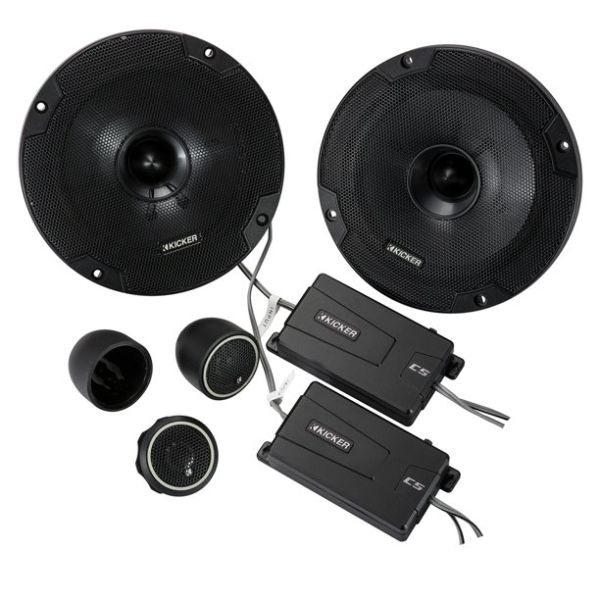
Kicker has designed their 46CSS654 CS-series 2-way 6-1/2″ car component speakers to be a hefty upgrade over what’s installed into most cars, trucks, and These speakers underwent extensive testing and development to guarantee that they perform well and last for a very long time. SUVs today. Woofer cones crafted from polypropylene are attached to the speaker’s durable stamped basket via ribbed polyester foam surrounds and 3/4″ titanium tweeters all but assure you that they are truly great-sounding speakers.
Boasting a woofer mounting depth of only 1-13/16″, you should find little installation woes in your vehicle of choice. Even the crossovers that come with them are small enough to fit under the dash or into a door for a covert location. Kicker thoughtfully provided some grilles for this exact purpose in case you need to protect the speakers.
You have a few options for powering them: the factory-installed radio, an aftermarket radio, or an amplifier. This 4-ohm car component speaker kit can handle up to 100 watts of continuous power and up to 300 watts of maximum power. So what are you waiting for? Click the “Add to Cart” button and start your journey to better-sounding audio today!
JL Audio C1-650 6-1/2″ C1-Series 2-Way
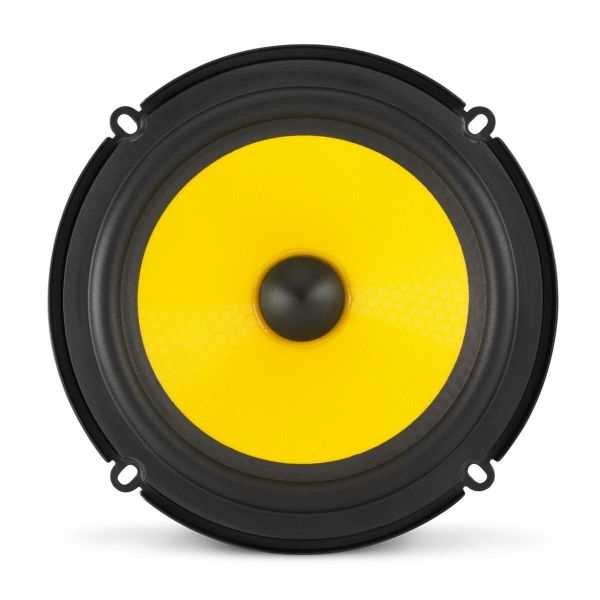
If you’ve ever looked at anything car audio-related, you probably saw the name “JL Audio” thrown around and for very good reason: they are one of the leading manufacturers in car audio and have been since their inception in the late 70s. The C1-650 6-1/2″ car component speakers from JL have quite the pedigree to uphold, but they do it with ease. The mineral-filled, injection-filled polypropylene woofer cones are robust yet lightweight, ensuring dynamic midrange and midbass performance. These woofer cones have a sturdy rubber surround that secures them to the stamped woofer baskets. It used aluminum dome tweeters that are edge-driven and produce a crisp, but not overly bright, high-frequency response. The installation process is greatly streamlined by inline outboard high-pass filters, which shield the tweeter from damaging frequencies while being small enough to tuck away almost anywhere.
The best part is that, despite the fact that the speakers can handle continuous power of up to 50 watts, their 91dB sensitivity guarantees that they will perform admirably using factory-installed radio power through aftermarket amplification. By removing your vehicle’s factory speakers and replacing them with the JL Audio C1-650 car speakers, you can easily upgrade the sound in your vehicle.
Kicker 47KSS6504 6-1/2″ KS-Series 2-Way
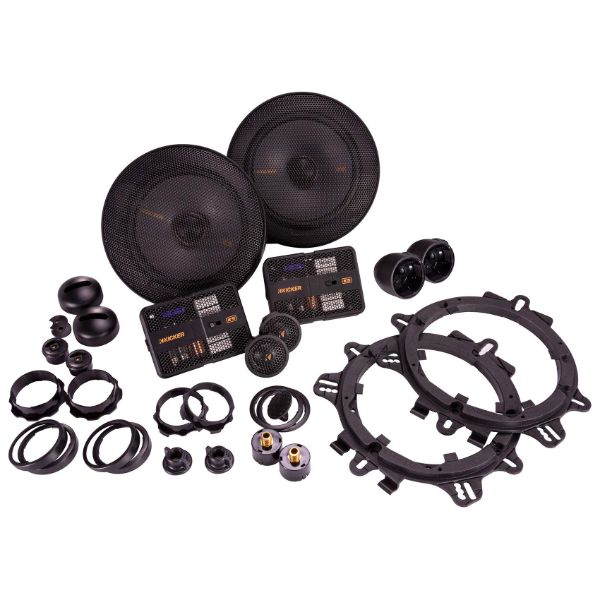
You might have noticed that we like Kicker speakers. There’s a good reason why; let us tell you about one of our personal favorites: Kicker’s KSS6504 6-1/2″ 2-way car component speakers. While this KS-series speaker kit shares similar polypropylene woofer cones with its DS- and CS-series speakers, the 1″ silk dome tweeters are quite different. The fact that silk dome tweeters can sound extremely smooth without any of the harshness that some metal tweeters produce is one of their best features.
The woofer surrounds for this speaker kit have been upgraded to a durable rubber material, which will outlast the foam alternatives found in some other speaker kits. We are aware that we just mentioned the woofer cones for this speaker kit, but we did not want to forget to mention that. The phase plugs, which are part of this kit and are the bullet-shaped pieces in the middle of each woofer, are another interesting fact. A phase plug’s primary duty is to ensure that all the sound created by the woofer is pushed out towards your ears, not “stuck” at the front of the woofer and affecting the rest of the frequencies that the speaker is dutifully creating.
The 47KSS6504 component speakers have a 4-ohm impedance and would prefer continuous power of up to 125 watts, but they can also handle peak power of up to 250 watts. Like the DS- and CS-series equivalent speakers, the KS-series variant has a mounting depth of just 1-13/16″, so that should simplify your installation quite a bit versus some deeper speakers that could begin making contact with components inside of the door, for example. Depending on where the tweeters are located in the vehicle, you can adjust the tweeter output using the included crossover networks to get a better sound. It is among the best car speakers.
To increase versatility, we can take out those phase plugs we mentioned earlier and mount the tweeters in that cavity. As a result, the Kicker speakers are now configured coaxially rather than as components. This can be useful if you switch cars and the new one doesn’t let you mount the tweeter in a different place. Kicker seems to have thought of everything, right?
Infinity Reference 5030cx
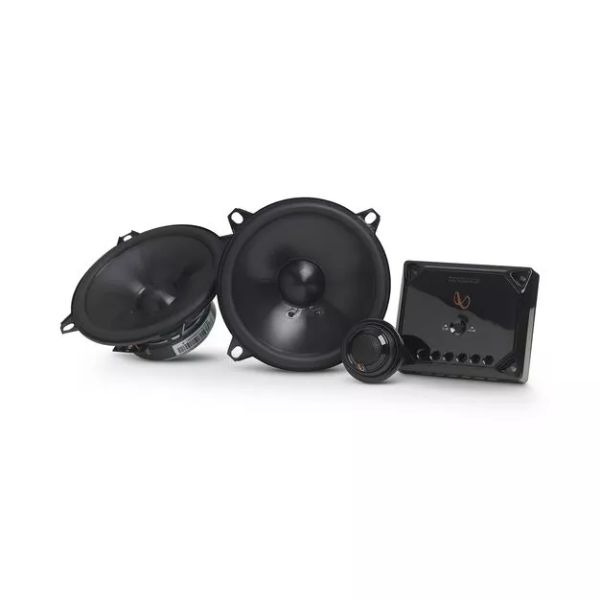
The 5030cx, which was first offered in 2019, is still our top choice. The Reference 5030cx has established a reputation for handling power with clarity and longevity, and they have done so at a very affordable price point. These 5.25″ The patented Plus One™ technology, which enables a larger cone area, is used in reference component speakers. The sensitivity and frequency range of an object may be affected by its cone area. The speaker will typically perform better at producing lower frequencies (bass) if the cone area is larger. And for the highs, a .75″ edge-driven textile tweeters hit the high frequencies with ease, even when pushing the system to its max.
The fact that these speakers are so adaptable is fantastic, even though they might not be the speakers on our list with the best performance. They are a great match for those looking to simply use a factory or aftermarket head unit for power because they have a 65W RMS power handling capacity and a 93dB sensitivity rating. These performance specifications, along with the fact that they are reasonably priced, make them a great choice.
Tips For Looking For The Best Car Audio Speakers
There are a few considerations you should make when shopping for speakers for your car’s audio system, and we’ll go over some of them now.
Car Speaker Types
Prior to purchasing a speaker system for your car, the type of speaker is the most important consideration. The first is a full-range speaker, and the second is a component speaker.
Coaxial Speakers
The most widely used and most basic speakers available are these. They go by the name coaxial speakers as well. Both the tweeter and the woofer are present in the speakers, with the former handling higher frequencies. Low- and mid-range bass frequencies are the domain of woofers. These models are less expensive and require fewer modifications because of how straightforward their design is. Due to the ability to control the soundwaves’ path, you can purchase up to four-way coaxial speakers, which vastly enhances the audio quality.
Component Speakers
This kind of car speaker consists of individual components dispersed throughout the vehicle and lets you regulate the music flow depending on how they are mounted. You can make sure that the tweeters and woofers are channeling different frequencies to play to their strengths by properly wiring them. With component speakers, the music quality is at its best because of the extra control. However, they will take a lot longer to install and are more likely to require modifications to the vehicle.
Material
Although there are many factors that affect a speaker’s quality, the speaker’s material is one of the most crucial. Because rubber is stiff, lightweight, long-lasting, and durable, rubber-encased speakers are among the best ones currently on the market. The extreme flexibility and heat resistance of rubber make it a fantastic alternative as well.
However, they are typically less expensive and do not last as long as rubber speakers. Other materials, like foam and cloth, can produce a more refined sound. When it comes to speakers, you get what you pay for; even though some options may be more expensive than others, the more expensive choice will offer you the best value in terms of dependability and general quality.
Installation
Installation of the speakers typically takes place behind the protective grill, and the size of the speaker you can purchase depends on the available space (unless you want to make modifications). The audio quality improves as space increases. The installation process is simplified by the manual that is included with the best speakers.
Range Of Frequency
The overall sound quality and how it is perceived by you in your car are determined by the frequency range. By changing the frequency in the speakers, for instance, you can enhance the effect of the sound. Crossovers between the woofer and tweeter are necessary to capture otherwise wasted power and achieve an even frequency distribution.
Sensitivity Of The Speaker
The speaker sensitivity rating, which describes how loud the car speaker system is, is a crucial sign to look for. A speaker will produce a louder sound, measured in decibels (dB), for instance, if its decibel rating is higher. The best car speakers will produce clear sound even at high volumes if they have a sensitivity rating of at least 88 decibels, so keep that in mind when shopping.
Power Rating
Consider the maximum wattage (which shows how many watts the speakers can handle) and the power rating when choosing a speaker system. Because most people associate speakers with bass when they think of attributes, this one is the most flaunted.
If your system is low-powered, your speakers don’t need to be able to handle a lot of power.
Conversely, a system with strong external amplifiers will require speakers with power handling close to the output of the amplifiers. 10-15 watts per channel are typically enough to listen to music at a medium volume in a car.
RMS Index
Compare the speakers’ power handling capacity and sensitivity rating if you want your in-car music to be loud but clear. This factor is displayed in Watts (or W), with RMS being the most important rating. The maximum continuous power that the speaker can handle is indicated by the Root Mean Square power rating.
Labels
Remember that a single pair of speakers cannot reproduce qualitatively the entire frequency range of sound perceived by the human ear (from 20 Hz to 20 kHz), so do not rely on the labels on the packaging of speakers of questionable origin. This necessitates at least a three-way system, which includes:
- High-frequency speakers (tweeters) capable of reproducing frequencies ranging from 4 to 20 kHz
- Speakers in the midrange (500 Hz to 5 kHz)
- The mid-bass (80 to 1kHz)
- Woofers (from 30 to 100 hertz) – subwoofers
Size
The sound quality of your car will be significantly impacted by the size of the car speakers you choose. Your car may not be able to accommodate all car speakers. The existing speaker ports may need to be modified to fit the new replacement speaker if you purchase the incorrect size. Therefore, when you go shopping for replacement car speakers, make sure they will fit in your vehicle. This is why it’s crucial to comprehend the various car speaker sizes that are available today. To choose the appropriate size and make a wise purchase, you must first determine what size speakers are in my car.
Maneuverability
A car speaker system has two different levels of maneuverability. With a speaker system that has swiveling tweeters, you can easily adjust the speakers to direct the sound in different directions at you or your passengers. These can be a lifesaver, for instance, if you have to install the speakers in a confined space or a challenging location in order to access them. One solution to this issue is component speaker systems. However, if you own multiple vehicles or want to be able to quickly remove your speakers if you purchase a new car, you may discover that installing a detachable tweeter in a different modular system is simple.
See more about 10 Best DSP For Car Audio
Ways To Upgrade Your Car Speakers
You might be relieved to learn that most vehicles make it simple to upgrade the factory speakers if you’re not entirely happy with how well they perform. The fact that aftermarket speakers are widely available and reasonably priced—generally much less expensive than an optional factory stereo package—is more important.
Unfortunately, not all vehicles use the same speaker size, and some require more work to upgrade than others. This guide’s objective is to provide you with a general overview of what to look for when upgrading your car speakers, as well as some advice and instructions on how to do it. Since every vehicle is different when it comes to disassembly, one of the trickiest steps will be gaining access to your factory speakers.
Choose The Right Speakers
When looking for replacement car speakers, there are a few things to keep in mind. You should check the size of the speakers your car came with first. You should purchase speakers of the same size in order to make the installation process as simple and seamless as possible. Most likely, the retailer from which you are buying new speakers will be able to tell you what size your factory speakers are. If you’re absolutely determined to replace them, you can also measure the speakers directly.
Making the choice between component and coaxial replacement speakers is the next choice you must make. In general, component setups will sound better than coaxial speakers, but they are more expensive and might need a more specialized installation. If the size is the same, coaxial speakers will typically be a direct OE replacement.
If you don’t want to install a new head unit, make sure the speakers you buy can handle the power coming from the factory unit. If you really want to enhance the sound in your cabin, you can also install a separate amplifier to drive those speakers. When shopping for speakers, you will normally see a “power handling” specification in “RMS” and “peak.” You should focus on RMS, which stands for root-mean-square, rather than peak, as the value. That’s because RMS refers to the amount of power the speaker can handle continuously, whereas peak refers to the amount of power the speaker is capable of using in brief bursts.
The sensitivity of a speaker, also known as SPL, is another feature to consider. It is measured in decibels and describes the amount of power required by a speaker to produce a specific volume. You should be aware that speakers with a higher sensitivity draw less power, so if your factory head unit doesn’t offer much power, invest in a set of high sensitivity speakers.
It’s a little trickier to upgrade your vehicle’s entire sound system than it is to simply replace the speakers. If you want a full system upgrade, you might need to buy an aftermarket head unit, an external amplifier, and even a subwoofer. This article will concentrate on simply replacing the stock speakers in your car, which is a good place to start when upgrading your stereo.
Tools You Need
When it comes to accessing the factory speakers, as we already mentioned, every vehicle will have a unique disassembly procedure. The following tools are a good place to start, and you should have them organized and prepared before beginning the process.
- Allen wrenches
- Crimping tools
- Drill with bits
- Electrical tape
- File
- Flat head screwdriver
- Panel popper
- Phillips screwdriver
- Socket wrench
- Soldering iron and solder
- Torx drivers and bits
- Wire cutter/wire stripper
Access Front Dash Speakers
Front dash speakers are usually fairly simple to access if your car has them. The speaker itself can typically be accessed by removing the speaker grille, though if the speaker is close to the windshield, a 90-degree screwdriver may be required to access the screws.
Take care not to scratch or damage your dash when removing the speaker grille. To remove the grille, a panel popper works best. If you find that the grille isn’t coming off very easily, halt and look underneath to see if there are screws holding it in place. To access the speakers in that situation, you might have to take the dash apart completely.
Access Door Speakers
You are probably most familiar with door speakers. Depending on the model of your car, they are situated in the door panel and are also relatively simple to replace. Accessing the speakers and removing the door panel can be challenging in some vehicles but very simple in others. If you’re lucky, your car might allow you to simply remove the speaker grilles from the outside of the door panel in order to access the door speaker.
Use a panel popper or a flat head screwdriver to carefully pop off the door panel if you need to access the speakers. Make sure you check for any plugs that need to be disconnected because some door panels may be trickier to remove than others. There may be a few disconnections needed before you can safely remove a door panel because a typical door panel has switches for your power windows and doors.
Once you are able to access the speaker, remove the grille if necessary then head over to the “General Steps” section on how to replace the speaker.
Access Rear Deck Speakers
The hardest speakers to reach frequently are the rear deck speakers. If you’re lucky, some cars have dash speakers that can be easily removed by popping off the grille and gaining access to the speaker’s screws. Other vehicles might require you to remove the entire back seat and the rear trim pieces in order to access them, or you might need to use your trunk.
Be cautious if you need to remove some panels to get to your rear deck speakers, just like you would to get to the dash and door speakers. Find any connectors that require disconnection by looking around. Once you’re able to access the speakers head over to our “General Steps” section.
General Steps
The steps listed below are general guidelines for changing the speakers in your car. Once more, specific procedures might vary depending on your car, but this should give you a general idea of what’s required to replace your factory speakers.
Disconnect Your Battery
The negative terminal of your battery needs to be disconnected before you start. You don’t want to drain your guard’s battery because the doors to your car will be opened during the installation. What’s more, disconnecting your battery will stop short circuits from happening while you’re working with the wiring.
Remove The Factory Speaker
At this point, whether your speakers are in the dash, door, or rear deck, we’re assuming that you have gained access to them. Simply unscrew the speaker since it will likely be secured by screws. Carefully unplug whatever connector is behind the speaker before removing it completely.
Install The New Speaker
If a new harness was included with your new speakers, connect it to the terminals on the new speakers. If not, establish the necessary connections in order to connect your speakers to an audio signal.
Test The New Speaker
You might want to give the new speaker a brief test to ensure that it is functional before you tighten it into place. This is essentially all that needs to be done before reassembling your dash, door, or rear deck if you’re installing coaxial speakers.
What About The Components?
If you’re installing a component set, you’ll probably need to mount your separate tweeter and install a crossover. If you want to mount the tweeter there, you’ll typically need to drill and cut into your door panel or A-pillar. Coaxial replacements are advised for direct OE replacement upgrades because this is a more specialized process.
Faqs
Does A Four-way Speaker Outperform A Two-way Speaker?
Given that mid-range and high-range sound are handled by separate drivers, a three-way or four-way speaker should, in theory, produce clearer sound. However, the crossover’s design and tuning, as well as the size and material of each component, have a significant impact on sound quality. There are many expensive two-way speakers that produce clearer sound than less expensive three-way speakers with paper cones.
Which Car Speakers Have The Best Bass? How Can I Make My Car Speakers’ Bass Stronger?
A subwoofer and an aftermarket amplifier are the only surefire ways to add the powerful, assured bass you’re craving. Different speakers will meet different needs. Start by replacing your stock speakers with an aftermarket set known to deliver respectable bass response if an aftermarket subwoofer isn’t in your budget. Always keep in mind that larger speakers can frequently be installed with only minor modifications, and that, generally speaking, the bigger the woofer, the stronger the bass response. If your car stereo has a mid-range response control knob, try adjusting it lower to emphasize the highs and lows of the bass and treble settings.
How Does Frequency Response Work?
The more accurate a speaker is at delivering sound at the low and high ends of the audio spectrum, the wider its frequency response. To ensure adequate bass clarity, look for a frequency response of 35 hertz or less. In component systems, individual speakers (separate woofer, tweeter, and occasionally mid-range) frequently have a narrow frequency response tuned specifically to reproduce the entire frequency range over the entire system.
Do Larger Speakers Perform Better? Does A Car Need More Than Four Speakers?
Yes, bigger is better if all other factors, including build quality and materials, are equal. Air is moved by speakers to produce sound. The sound gets louder and clearer as the cone gets bigger. The natural advantages of a larger speaker surface can be enjoyed while keeping costs to a minimum by upgrading many car speakers to the next size up. Smaller speakers also enhance the quality of sound in various areas of the audio spectrum. A few big speakers are good for volume and for providing all passengers with equal and high-quality sound. Different interior sizes, particularly for vans or large vehicles, may also require a larger number and a more varied array of speakers.
Can I Install Aftermarket Car Stereo Speakers On My Own?
It’s now simpler than ever to access in-door speakers thanks to video installation guides made for specific vehicle models. Get a set of Metra quick-connect speaker harnesses made for your particular vehicle to simplify installation. Component speakers that have separate tweeters are a little more difficult to install, and a professional in car audio should be hired to install an aftermarket amplifier or stereo head unit in a modern vehicle.
Conclusion
We picked the top-rated speakers noted for providing the best sound quality for their intended use in order to compile our list of the best car speakers for 2022. In order to rank speakers objectively, we considered their material composition, frequency response, and peak power handling, which are indicators of clarity and volume without distortion, respectively.
By taking into account a wide range of end-user reviews, expert assessments, and individual experiences with aftermarket audio products, Forbes Wheels chose five of the best speakers and speaker component setups. The listener’s satisfaction with the bass response was the most important factor we took into account when determining our top rankings, as strong bass is the factor that is mentioned the most frequently in forum posts and online reviews.
I appreciate you reading.


